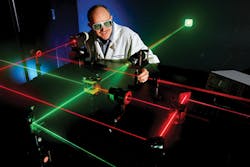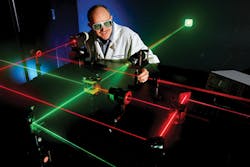Engility to find cutting-edge optical warfare uses for light and lasers
WRIGHT-PATTERSON AFB, Ohio - Laser protection experts at Engility Corp. in Andover, Mass., are finding new ways to use infrared, ultraviolet, visible light, and lasers for offensive and defensive purposes in the emerging discipline of optical warfare.
Officials of the Air Force Research Laboratory at Wright-Patterson Air Force Base, Ohio, have announced an $8.5 million order to Engility for additional work in the Optical Radiation Bioeffects and Safety (ORBS) program. Engility experts seek to understand, mitigate, and exploit the effects of ultraviolet, visible, and infrared optical radiation devices and their countermeasures on U.S. military personnel and aerospace missions.
Engility will continue looking for new ways to diagnose and treat combat injuries due to optical radiation; improved methods of combat casualty care, including triage, diagnosis, and treatment; and simulating laser injury to assess mission performance.
The notion of optical warfare involves the use of light for weapons, communications, sensors, defensive measures, surveillance, and other instruments of warfare. Optical warfare is one component of an emerging military discipline called spectrum warfare, which also includes electronic warfare (EW) and cyber warfare.
The ORBS program seeks to identify, develop, and perfect new technologies for using lasers and other kinds of light emitters as weapons, as well as for protecting military personnel from the effects of lasers.
Engility experts will try to develop new technologies to diagnose and treat optical warfare combat injuries; find economical and efficient ways to care for optical warfare combat casualties; and simulate laser injuries to help develop laser weapons and laser protective technologies. Engility will do the work at Joint Base San Antonio-Fort Sam Houston, Texas, and should be finished by April 2020.
FOR MORE INFORMATION visit Engility Corp. online at www.engilitycorp.com.

